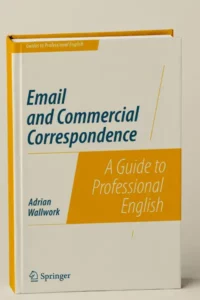Email and Commercial Correspondence will stand a much greater chance of getting the desired reply to your emails in the shortest time possible.
Email and Commercial Correspondence PDF
If you write emails and letters as part of your work, then this book is for you. By applying the suggested guidelines, you will stand a much greater chance of getting the desired reply to your emails in the shortest time possible.
Some of the key guidelines covered include:
- Write meaningful subject lines – otherwise, recipients may not even open your mail.
- Always put the most important point in the first line – otherwise, the reader may not read it.
- Be concise and only mention what is truly relevant. Write the minimum amount possible – you will also make fewer mistakes!
- Be a little too formal than too informal – you don’t want to offend anyone.
- If you have two long important things to say, say them in separate emails.
- Give clear instructions and reasonable deadlines.
- If you need people to cooperate with you, it is essential to highlight the benefits for them of cooperating with you.
- Empathize with your recipient’s busy workload.
- Never translate typical phrases literally – learn equivalent phrases.
The book concludes with a chapter of useful phrases. There is also a brief introduction for trainers on how to teach Business / Commercial English.
Who is this book for?
If you write emails and letters as part of your work, then this book is for you – particularly if you are a non-native speaker of English. By applying the suggested guidelines, you will stand a much greater chance of getting the desired reply to your emails in the shortest time possible.
I hope that other trainers like myself in Business English will also find the book a source of useful ideas to pass on to students.
This book is NOT for academics. Instead, read chapters 1–6 of English for Academic Correspondence and Socializing (Springer Science), from which some of the subsections in this book are taken or adapted.
Is this a book of the rules of email or just a guide?
It is only a guide.
It is based on 20 years of my own personal emailing experiences plus courses that I have held over the last 10 years at IT companies and research centers. They are ideas that my clients have found useful and which have significantly improved their relationships with the recipients of their emails.
I suggest you try out the various strategies outlined in this book: if they work for you, great. If they don’t, then try another strategy. There is no one way that is guaranteed to be 100% effective.


